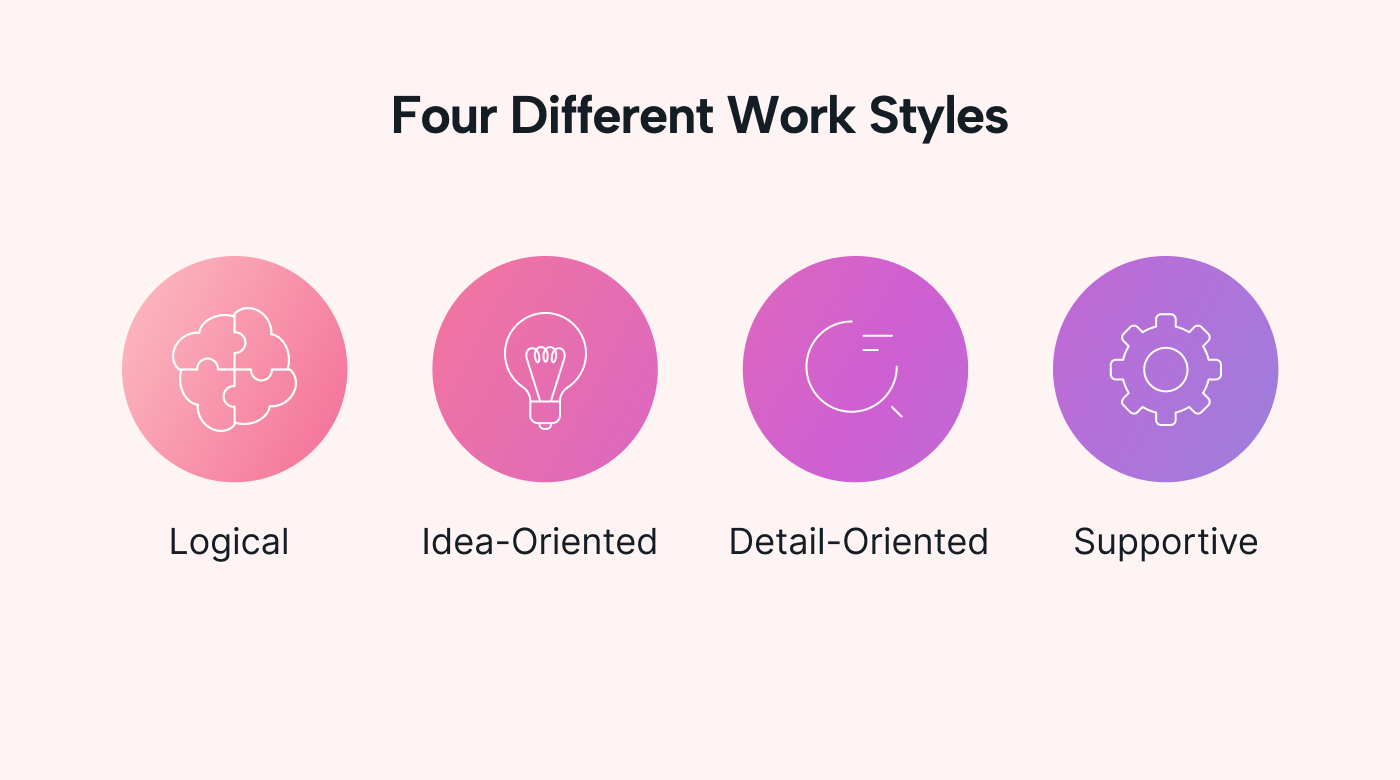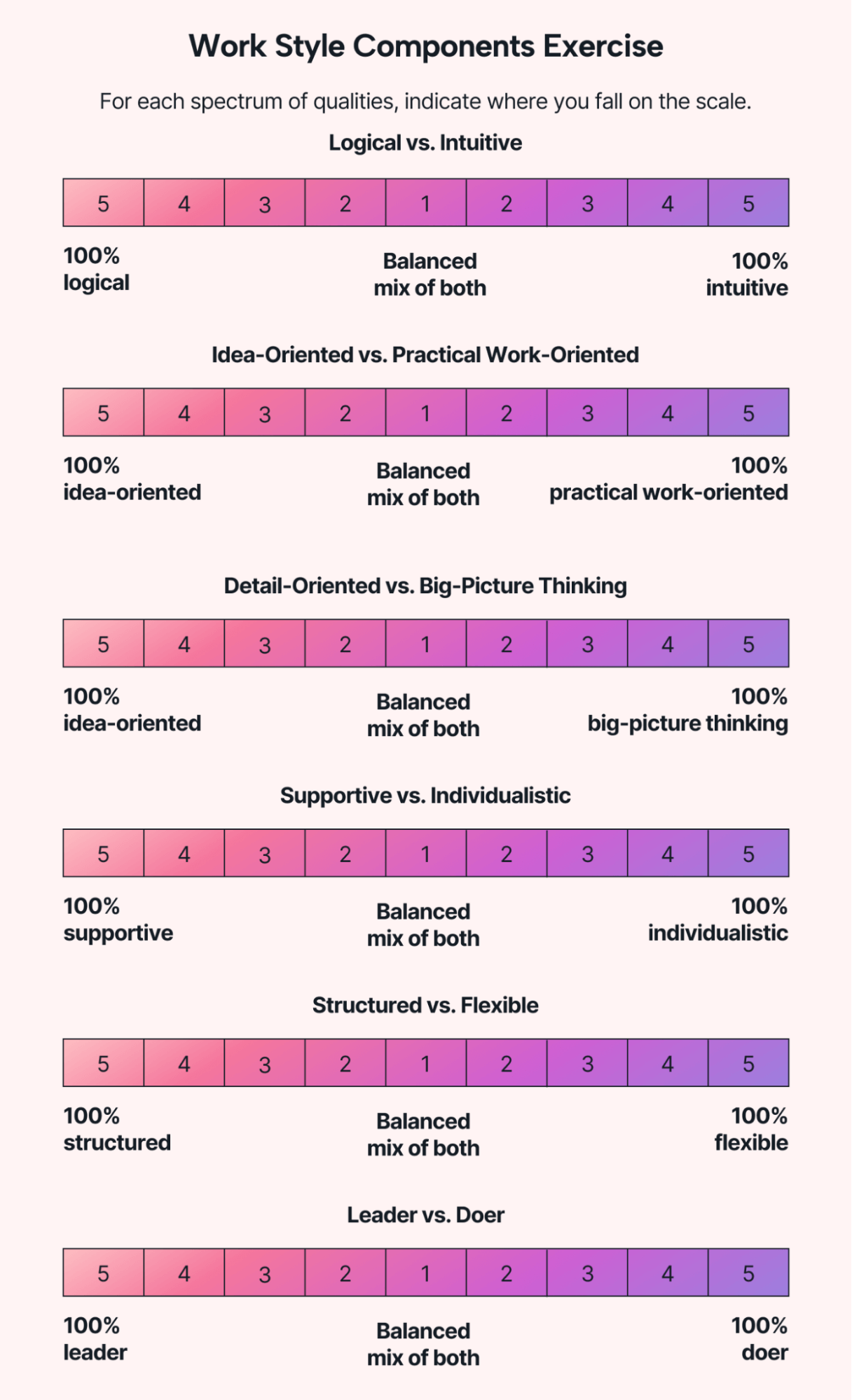What’s your work style?
This question is often asked during job interviews. It’s designed to help reviewers figure out how well the candidate might fit into the team — and, frankly, how well they know themself and can align their way of working to the job they’re interviewing for.
But the work style landscape is confusing. There are many work styles. Also, some people might change their style as their environment or role changes.
To clear up the confusion, we’ll cover six work style components and use them to build three detailed work style examples. After reviewing these components and examples, you’ll be well-prepared when the “What’s your work style?” interview question comes your way.
What are work styles?
Your work style refers to the blend of habits, preferences, and techniques that you use in a professional setting to get your work done.
While a work style might sound similar to a set of personality traits, the two are different — though there are some overlaps.
According to the American Psychological Association, “Personality refers to the enduring characteristics and behavior that comprise a person’s unique adjustment to life, including major traits, interests, drives, values, self-concept, abilities, and emotional patterns.”
Your work style, on the other hand, is best described as how you like to tackle tasks and interact with others in the workplace.
 |
While some work styles are based on innate personality traits and preferences, others are generated by your life experiences, previous job roles, and personal growth. Some of these factors can shape or even alter your work style over time.
The benefits of knowing your own and others’ work styles
Understanding your work style helps you, as an employee, select the best jobs and work environments for yourself.
For employers, the benefits include being better able to build synergistic teams and creating environments where individuals feel valued and understood. This, in turn, leads to more productivity, higher job satisfaction, and better employee retention rates.
Understanding work style spectrums
The essence of work styles is best explained by putting different ways of working on a spectrum.
For instance, think of the spectrum of working solo vs. with others. On one end, you find people who thrive when they’re working independently, and on the other are those who are at their best when they’re collaborating with others.
Employees may find themselves at either extreme of this spectrum or right in the middle, claiming, “I work well alone, but am also a good team player who knows how to work well with others.”
Several of these spectra are used in work style classifications — which we’ll explore in more depth in the next section.
The main components of work styles
There’s no shortage of systems that categorize work styles. Each offers unique insights into our preferred professional behaviors.
One popular work style classification system uses four categories: Logical, Idea-Oriented, Detail-Oriented, and Supportive.
 |
Let’s explore the spectra that these categories are based on and introduce more complete work style examples.
Logical vs. intuitive
This spectrum analyzes how individuals process and evaluate information.
Logical:
Employees in this category typically approach problems and situations systematically. They excel at analysis, critical thinking, goal setting, and reasoning.
For instance, a logical employee would meticulously go through data to come to a conclusion about a project’s viability.
These individuals’ dependence on concrete data may limit their ability to think outside the box or make decisions when they don’t have all the information.
Intuitive:
Intuitive individuals often rely on their gut feelings to understand situations and make decisions, even if they can’t reason through every detail. They might suggest a new strategy because it “feels right,” even if they don’t have all the data to back it up.
However, relying heavily on intuition can sometimes lead them to overlook important details that can be critical to a situation.
Idea-oriented vs. practical work-oriented
This spectrum examines the balance between conceptual thinking and hands-on execution.
Idea-oriented:
Idea generators are innovators and visionaries. For example, in a brainstorming session, they might come up with a groundbreaking marketing idea.
These individuals have the ability to think outside of the box to see new possibilities, and they thrive in fast-paced environments.
While idea-oriented people are great at ideation, translating those ideas into actionable tasks can sometimes be challenging for them.
Practical work-oriented:
These doers are at their best when they focus on practical, hands-on tasks. They shine when given tangible tasks. So, when an idea is approved, they excel at executing it effectively and efficiently.
These individuals can occasionally become too focused on the task at hand, missing out on alternative and potentially innovative solutions.
Detail-oriented vs. big-picture thinking
This spectrum covers one’s focus on tasks. It illuminates the contrast between individuals who excel at diving deep into specifics and those who prioritize the broader overview.
 |
Detail-oriented:
These employees love working with and staying on top of details. They often excel in roles like quality assurance, where they can spot even minor inconsistencies in products. They tend to be meticulous, and nothing escapes them.
However, being too caught up in details can sometimes prevent them from appreciating the overarching strategy or goal, which can cause them to lose sight of it.
Big-picture thinking:
Big-picture thinkers quickly see the totality of a situation and grasp the fullness of its meaning. For instance, if the company is considering a merger, these individuals quickly understand its strategic implications without getting bogged down by minor logistical challenges.
While they’re great at conceptualizing grand visions, they can sometimes overlook the nitty-gritty, underestimate challenges in execution, or be impatient in moving information to the level of practical implementation.
Supportive vs. individualistic
This spectrum indicates how people function within or outside a group.
Supportive:
These employees have strong social skills and excel in team settings. They often act as the glue that holds the team together by mediating conflicts and cementing harmonious collaboration.
Sometimes, their dedication to harmony can prevent necessary confrontations or critical feedback.
Individualistic:
Due to their independent working style, these workers shine when they have autonomy. They prefer to manage tasks on their own, drawing from their personal expertise. They often act as the go-to people for projects that require deep concentration and individual expertise.
Their tendency to work alone can sometimes isolate them from team dynamics, potentially leading to communication gaps.
Let’s add some additional elements from other classification systems.
Structured vs. flexible
This spectrum highlights the difference between those who thrive in well-defined environments and those who excel amid fluidity.
Structured:
These employees work best in well-defined settings. They prefer having clear instructions and deadlines and are great at time management. Think of a project manager who has a detailed timeline for each phase of a project.
However, their reliance on structure might make them less adaptable to sudden changes or unexpected disruptions. They may find impromptu situations stressful.
Flexible:
These workers thrive in dynamic environments. They are adaptive and can pivot based on situational needs. In startup environments, where roles are fluid, these individuals acclimate well.
Due to their adaptability, these individuals sometimes overlook the benefits of long-term planning or disregard established processes.
Leader vs. doer
This spectrum offers insights into whether an individual leans more toward steering the ship or being the engine that powers it.
 |
Leader:
These workers naturally gravitate toward leadership roles. They’re comfortable with decision-making and taking responsibility. During crises, they’re the ones who rally the troops and chart the way forward.
Due to their focus on the 30,000-foot level, they sometimes overlook ground-level challenges or the nuances of execution.
Doer:
Doers are the backbone of any organization. They excel at execution and prefer clearly defined roles over leading. When a leader outlines a vision, the doer is essential to bringing that vision to life.
Doers sometimes shy away from taking any initiative or voicing their perspectives, especially if those perspectives contradict the established direction.
Work style examples: How work style components combine into individual work styles
Now that we’ve looked at some of the key components of working styles, let’s combine them into personal work styles.
Each person is unique in how they combine the potentially limitless ways of doing things to form actual work styles. Here are three detailed examples:
1. The visionary innovator
Dominant traits: big-picture thinking, idea-oriented, flexible, individualistic
Visionary innovators brim with ideas, often visualizing grand visions and expansive strategies and suggesting novel solutions and innovative approaches to projects. Their individualistic streak ensures they aren’t afraid to venture off the beaten path or challenge the status quo.
They can easily formulate overarching strategies and see where the company or project should be heading in the long run.
And if their grand vision hits a roadblock, they’re not daunted. They pivot, adapt, and find another way. This makes them invaluable in dynamic environments.
 |
Preferring to carve their own path, visionary innovators are not always team players in the traditional sense but can inspire others through their zeal.
2. The analytical executor
Dominant traits: logical, detail-oriented, structured, doer
A combination of logic and meticulous attention to detail makes people with this work style masterful at transforming complex plans into actionable tasks. They thrive in structured environments.
With their logical prowess, they dissect problems before determining the most efficient solutions. Missed details aren’t in their vocabulary — instead, they make sure every aspect of a project aligns perfectly.
As natural doers, once they have a plan, they’ll execute it to perfection.
Their love for structure means they often have systems in place for everything to ensure efficiency and consistency all around.
3. The intuitive team anchor
Dominant traits: intuitive, supportive, flexible, leader
People with this work style tend to be the understanding, compassionate heart of the team. They have a knack for reading between the lines and offer both leadership and camaraderie, making them indispensable in groups.
Their intuition helps them understand their fellow team members’ unspoken concerns or potential challenges, which builds a supportive environment. As natural leaders, they inspire trust and motivation and ensure everyone is working toward a unified goal.
These individuals often set the tone for team or company culture, making everyone feel valued and heard. Their flexibility means they can adjust the team’s course to navigate challenges effectively, even in turbulent times.
It’s easy to see how each of these work styles brings a unique blend of strengths to the table.
There are many more possible combinations. What’s yours?
How to determine your own preferred work style
Now that you’ve seen how a variety of work preferences act as the building blocks of personal work styles, here are some suggestions for figuring out your own style:
1. Self-reflect
Taking a moment to reflect can be enlightening. Consider past projects you’ve worked on. When did you feel most productive or satisfied? Think of both the circumstances and the way you tackled the projects.
Your answers will give you clues about your predominant work style.
2. Ask others for feedback
Feedback, especially from colleagues and supervisors, can reflect aspects of your work style back to you that you might have been unaware of.
Encourage open discussions — and do so without defensiveness. You might be surprised at the insights you gain.
3. Use our rating scale
Use the exercise below to rate yourself on each of the work style components we’ve discussed.
 |
Afterward, write a composite picture of your own work style that reflects your preferences and strengths.
4. Use online assessments
If you’re eager to dig deeper, use one or more of the numerous online tools, from quick quizzes to in-depth style assessments, that can guide you in pinpointing your work style.
Free tools will offer you a taste of your profile. Spending some money on more comprehensive assessments, however, will provide richer insights.
Here are some examples of tools you can use to assess yourself:
Use Motion’s AI-driven calendar to support your work style
We hope the work style examples in this article have inspired you to determine the one you prefer. Once you know what it is — and how to answer that interview question, “What’s your work style?” — don’t forget to tailor your online calendar to that style.
Motion’s AI-driven intelligent calendar, with its dynamic scheduling, reminders, and planning capabilities, can be tailored to complement various work styles — whether you’re meticulously planning and organizing individual tasks or mapping out long-term goals and project timelines.
By customizing and leveraging its features, you can align your productivity process with your preferred work style.





